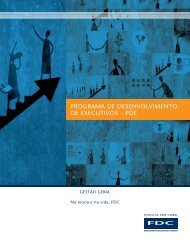Industrial action to measure and improve corporate responsibility's ...
Industrial action to measure and improve corporate responsibility's ...
Industrial action to measure and improve corporate responsibility's ...
You also want an ePaper? Increase the reach of your titles
YUMPU automatically turns print PDFs into web optimized ePapers that Google loves.
<strong>Industrial</strong> <strong>action</strong> <strong>to</strong> <strong>measure</strong> <strong>and</strong> <strong>improve</strong> <strong>corporate</strong> responsibility’s results:<br />
theoretical <strong>and</strong> practical arguments.<br />
Rafael Tello<br />
Luana Dapieve<br />
Luisa Valentim<br />
Cláudio Boechat<br />
The capacity of <strong>corporate</strong> responsibility practices <strong>to</strong> <strong>improve</strong> companies’ competitive<br />
performance is not very clear, although research projects have found correlation between<br />
them at different levels. The main problem is <strong>to</strong> determine the causality, which usually can be<br />
recognized only in case studies.<br />
At the business level, many case studies have concluded that a more responsible management<br />
based on dialogue with stakeholders can <strong>improve</strong> company competitiveness (FAHI, ROCHE<br />
<strong>and</strong> WEINER, 2005). That is so because answering <strong>and</strong> recognizing the stakeholders’<br />
necessities can strengthen the relationship between them <strong>and</strong> the company, foreseeing risks<br />
<strong>and</strong> opportunities for the company in its sec<strong>to</strong>r. As by-products, firms can enhance efficiency<br />
<strong>and</strong> productivity.<br />
On the national level, in 2005 an initiative of both, the London-based NGO AccountAbility<br />
<strong>and</strong> Brazilian business school Fundação Dom Cabral, was <strong>to</strong> <strong>measure</strong> the relationship<br />
between responsible practices <strong>and</strong> environment <strong>and</strong> the competitiveness of countries/nations<br />
(ACCOUNTABILITY <strong>and</strong> FUNDAÇÃO DOM CABRAL, 2005). It was the second version<br />
of the Responsible Competitiveness Report with <strong>improve</strong>d indexes <strong>to</strong> analyze that<br />
relationship. The statistical changes on the National Responsible Competitiveness Index <strong>and</strong><br />
the Responsible Competitiveness Index made them more robust <strong>and</strong> trustful. Even with the<br />
changes, once again a strong correlation was found – more than 80% – between the<br />
responsible practices <strong>and</strong> the competitive economic levels of the countries<br />
(ACCOUNTABILITY <strong>and</strong> FUNDAÇÃO DOM CABRAL, 2005). It was found that many<br />
countries have a strong performance inequality between these two parameters. This suggests<br />
that despite the capacity of <strong>corporate</strong> responsibility <strong>to</strong> foster economic results of companies, it<br />
does not spread <strong>to</strong> the national competitiveness environment naturally. In other words, it<br />
could mean that responsible business practices are not being properly explored in achieving<br />
higher levels of competitiveness in each country. Some good examples are China, United<br />
Arab Emirates, Algeria <strong>and</strong> Tunisia.<br />
This paper proposes the use of coordinated industrial <strong>action</strong> <strong>to</strong> spread the results of each<br />
firm’s responsible practices <strong>to</strong> other companies in its sec<strong>to</strong>r. This kind of organization is<br />
recommended because companies have similar stakeholders but different management<br />
systems (HUNT, 1999) which make benchmarking <strong>and</strong> networks possible <strong>and</strong> easier <strong>to</strong> do.<br />
Many business associations already collect data from their associates <strong>and</strong> publish the results<br />
<strong>to</strong> the wider public. But, until <strong>to</strong>day, the capacity of these institutions is much underestimated<br />
(HÄMÄLÄINEN, 2003). Once they have access <strong>to</strong> information from the whole industry they<br />
can easily find best practices in the industry <strong>and</strong> coordinate benchmarking initiatives.<br />
Additionally, these associations are quite able <strong>to</strong> identify general weaknesses among their<br />
associates <strong>and</strong> therefore are able <strong>to</strong> propose mature projects <strong>to</strong> coordinate combined efforts of<br />
companies, government, universities <strong>and</strong>/or international institutions <strong>to</strong> solve those <strong>and</strong> thus,<br />
broaden the positive effects of responsible practices.
In Brazil many associations have already organized information about responsible practices<br />
<strong>and</strong> results of their associates. This <strong>action</strong> has two main effects: (1) they inform their<br />
stakeholders <strong>and</strong> the society how the companies are performing <strong>and</strong>, what results they<br />
produce; (2) stimulate other companies <strong>to</strong> set out responsible practices <strong>and</strong> moni<strong>to</strong>r their<br />
<strong>action</strong>s <strong>and</strong> results. These results can already help institutions, managers <strong>and</strong> governments <strong>to</strong><br />
evaluate the impact caused by these companies as responsible agents. Undoubtedly these<br />
results can be <strong>improve</strong>d not only if the associations recognize their potential, but also when<br />
they adopt the appropriate <strong>to</strong>ols <strong>to</strong> find <strong>and</strong> spread best practices <strong>and</strong> <strong>to</strong> coordinate industrial<br />
responsible activities.<br />
Despite the positive effects of isolated sec<strong>to</strong>rial <strong>action</strong>s <strong>to</strong> <strong>improve</strong> the responsible<br />
performance of the industries, <strong>to</strong> developing countries the real benefits depend on the<br />
simultaneous <strong>improve</strong>ment of their competitiveness. So, it is quite important that the<br />
associations are able <strong>to</strong> develop their capacity of coordination. They can build up the<br />
programs <strong>to</strong> implement the responsible competitiveness of their members <strong>and</strong> finally, turn<br />
them in<strong>to</strong> real promoters of the sustainable development.<br />
In order <strong>to</strong> validate such assumptions, we will present <strong>action</strong>s done by Brazilian associations<br />
that <strong>improve</strong>d the responsible practices of their associates, <strong>and</strong> brought about broad results <strong>to</strong><br />
the sec<strong>to</strong>r as a whole. It may help other companies, in Brazil or abroad, <strong>to</strong> build up their own<br />
programs.<br />
COMPETITIVENESS AND CSR AT THE BUSINESS LEVEL<br />
Competitiveness is a concept originally developed <strong>to</strong> observe <strong>and</strong> compare the performance of<br />
companies or sec<strong>to</strong>rs (HÄMÄLÄINEN, 2003; KRUGMAN, 1994; KUPFER, 1991; LALL,<br />
2001). Authors claimed that firms obtained competitiveness by reducing prices or enhancing<br />
productivity (PORTER, 1990). The study of companies’ ability <strong>to</strong> <strong>improve</strong> their performance<br />
was neglected with the dominance of the neoclassical research in economics. Since the perfect<br />
competition theory is a pillar of neoclassical economics, it was impossible for companies <strong>to</strong><br />
differentiate themselves <strong>and</strong> reap higher profits in a sec<strong>to</strong>r (HUNT, 1999).<br />
Researches about companies’ capacity <strong>to</strong> gain competitiveness continued in many fields:<br />
evolutionary economics, Heterogeneous dem<strong>and</strong> theory, his<strong>to</strong>rical tradition, Resource-based<br />
tradition, Competence-based tradition, etc. The authors observed, in different ways, that<br />
companies were not homogeneous <strong>and</strong> that their paths of development were distinct (HUNT,<br />
1999). This indicates that companies could organize themselves <strong>and</strong> act in unique ways,<br />
obtaining different performances or competitiveness. The inclusion of path-dependency on the<br />
analysis avoids the tendency <strong>to</strong> equilibrium, so companies could build long lasting<br />
competitive advantages.<br />
According <strong>to</strong> Porter (2006) some of the sources of these advantages are innovative capability,<br />
strategy, quality of products <strong>and</strong> processes. These sources are internal <strong>to</strong> the company, but it<br />
is embedded in a region (city, state, country, etc). So, the firm depends on many institutional<br />
aspects provided by the region’s l<strong>and</strong>, society <strong>and</strong> government, <strong>and</strong> these fac<strong>to</strong>rs impact on<br />
their competitiveness (WEF, 2006; IMD, 2006). Companies’ activities have impacts on their<br />
regions <strong>and</strong> elsewhere, because of the globalization. This new scenario highlighted<br />
competitive issues, especially with the rise of China <strong>and</strong> India, whose companies are gaining<br />
market share at high pace through the exploration of cheap resources.
The conducts of companies <strong>and</strong> their consequences <strong>to</strong> society is one of the themes on the<br />
competitiveness debate. Many developed countries are concerned with the effect of China <strong>and</strong><br />
India’s growth in their economies. Their argument <strong>to</strong> protect domestic companies is based on<br />
accusations of bad economic behavior (inadequate working conditions, pollution, disrespect<br />
of international treaties, etc) of Asian companies <strong>to</strong> reduce costs <strong>and</strong> offer cheaper prices <strong>to</strong><br />
consumers. In spite of protests of governments, the view that we support is that Asian<br />
companies are providing cheaper products <strong>to</strong> the world, improving purchase power, obtaining<br />
new consumers <strong>and</strong> pushing economic growth.<br />
Global economy exposes the contradic<strong>to</strong>ry preferences of persons: as consumers they want<br />
cheaper <strong>and</strong> better products, but as citizens they also want companies <strong>to</strong> respect their<br />
stakeholders. Most companies are focusing in one objective, <strong>and</strong> the bigger ones are deciding<br />
<strong>to</strong> <strong>improve</strong> financial results, cutting costs with reallocation of the production <strong>to</strong> developing<br />
countries or firing many workers. Some recent examples are GM, Ford, Nike <strong>and</strong> even<br />
Lenovo, a Chinese company.<br />
In some ways it is possible <strong>to</strong> associate the development of cheaper <strong>and</strong> better products <strong>and</strong><br />
the <strong>improve</strong>ment of the companies’ responsible behavior. This is a challenge for firms <strong>to</strong><br />
promote Sustainable Development (SCHALTEGGER et al, 2002). Some companies are<br />
successful in achieving good results at both goals simultaneously, such as AEG group. That<br />
for long times focused on the <strong>improve</strong>ment of the efficiency of its products. These companies<br />
are trying <strong>to</strong> satisfy this new consumer <strong>and</strong> consequently build competitive advantages that<br />
may not result in higher performance <strong>to</strong>day, but will become crucial <strong>to</strong> define leaders of<br />
future markets (KUPFER, 1991). To summarize these changes, the International NGO<br />
AccountAbility created in 2003 the concept Responsible Competitiveness (ZADEK et al,<br />
2003). It was developed <strong>and</strong> in 2005 its definition was:<br />
The Responsible Competitiveness means markets where businesses are<br />
systematically <strong>and</strong> comprehensively rewarded for more responsible practices<br />
<strong>and</strong> penalized for the converse. Strategies for realizing Responsible<br />
Competitiveness aim <strong>to</strong> enhance productivity by shaping business strategies <strong>and</strong><br />
practices, <strong>and</strong> the context in which they operate, <strong>to</strong> take explicit account of their<br />
social, economic <strong>and</strong> environmental impacts. (ACCOUNTABILITY; FUNDAÇÃO<br />
DOM CABRAL, 2005, pg 8)<br />
Some authors describe competitive benefits achieved with responsible behavior. Schaltegger<br />
et alli (2002) affirm that companies that include in their strategy efforts <strong>to</strong> solve those issues<br />
develop new business opportunities, such as development of new markets <strong>and</strong> new marketing<br />
possibilities <strong>and</strong> reduction of production costs. Also, with a larger vision of their business <strong>and</strong><br />
challenges, firms <strong>improve</strong> their capacity <strong>to</strong> discover, evaluate <strong>and</strong> prevent risks. Scholars<br />
interested in innovation also highlight the importance of a broader view <strong>to</strong> increase the<br />
chances of an innovation becoming successful in the market (ADNER, 2006). Many real<br />
examples are given by Fahi, Roche <strong>and</strong> Weiner (2005). In their book, one chapter presents<br />
possible <strong>improve</strong>ments that companies can gather with Corporate Social Responsibility (CSR)<br />
<strong>and</strong> some real examples are used <strong>to</strong> illustrate it.<br />
CSR seems <strong>to</strong> increase companies’ capacity <strong>to</strong> <strong>improve</strong> their competitiveness, maybe even<br />
helping them differentiate themselves (BRUNO, 2006), increasing their perceived value <strong>to</strong> the<br />
consumers. But does this capacity remain effective at the country level, once companies have<br />
different management systems <strong>and</strong> strategies? How correlated are public <strong>and</strong> private
esponsibility <strong>to</strong> national competitiveness? Are regions with responsible companies <strong>and</strong> an<br />
adequate institutional environment more competitive?<br />
COMPETITIVENESS AND CSR AT NATIONAL LEVEL<br />
The question of the relevance of the competition of countries is older than Adam Smith’s<br />
seminal book “The Wealth of the Nations”. Here<strong>to</strong>fore, the mercantilism claimed that a<br />
positive trade balance would make a country richer. Classical authors argued that human labor<br />
was responsible for it, criticizing the promotion of exports <strong>and</strong> control of imports. One of<br />
them was Ricardo, who developed the theory of comparative advantage. In his view trade<br />
could <strong>improve</strong> the welfare of the countries, as long as they organize their production trying <strong>to</strong><br />
minimize opportunity costs of production (WALTER, 2005). The Ricardian view dominated<br />
economic analysis of international trade.<br />
The most famous criticism <strong>to</strong> it was done by Michael Porter (1990). His argument was based<br />
on a dynamic approach, on the importance of absolute advantages, once international<br />
resources were flexible, <strong>and</strong> on the evidence that societies (governments, companies, research<br />
centres, etc) are capable of creating their advantages, regardless resources endowment<br />
(PORTER, 2006; WALTER, 2006). Hämäläinen (2003) argues that competitive analysis is<br />
extremely important because of its holistic perspective <strong>and</strong> its capacity <strong>to</strong> <strong>measure</strong> the<br />
potential economic growth of a country in a global market (see HÄMÄLÄINEN, 2003,<br />
chap.1). He points out that research tradition did not have anything that differentiates it from<br />
other theories 1 , <strong>and</strong> he tries <strong>to</strong> overcome this weakness including the analysis of<br />
organizational issues in his theory, defending that it is a major determinant of a country’s<br />
competitiveness.<br />
Nowadays people in different positions <strong>and</strong> countries are concerned with national<br />
competitiveness, but what this means is unclear. The term is associated with economic<br />
growth, welfare, prosperity, etc. 2 Although it is not a precise concept, the growth of national<br />
competitiveness is a goal <strong>to</strong> governments of the USA <strong>and</strong> the European Union, which<br />
developed competitive strategies <strong>and</strong> empowered institutions <strong>to</strong> realize them (WALTER,<br />
2005; WEF, 2006). A broader range of elements that impact a country’s competitiveness<br />
(IMD, 2006; WEF, 2006) imply that governments with a focus on competitive <strong>improve</strong>ments<br />
must not only consider economic variables, but also law, public institutions, education, health,<br />
S&T, among others. 3<br />
The broader view is an evolution on the analysis of the conditions of a country <strong>to</strong> create<br />
wealth <strong>and</strong> support development, but it is not enough. The competitive view does not consider<br />
many aspects connected <strong>to</strong> the sustainability of countries’ growth processes. So, it is<br />
necessary <strong>to</strong> include new variables in present models or create new ones that allow the<br />
observation of new aspects, adequate with long-lasting growth rates.<br />
The first Responsible Competitiveness Report (ZADEK et al, 2003) tried <strong>to</strong> overcome this<br />
problem integrating responsibility variables, aggregated in the National Corporate<br />
Responsibility (NCRI). The NCRI was later connected <strong>to</strong> WEF’s Growth Competitiveness<br />
Index (GCI), creating the Responsible Competitiveness Index (RCI). The main objectives of<br />
1 For more details see Lall, 2001<br />
2 Walter (2005) shows many concepts given by many institutions.<br />
3 The IMD <strong>measure</strong> the competitiveness of the nations with 325 variables compiled in 4 pillars. The WEF uses<br />
126 variables in 9 pillars.
the index were <strong>to</strong> check the relationship between CSR <strong>and</strong> competitiveness, <strong>and</strong> how intense<br />
was it <strong>and</strong> what happened <strong>to</strong> the ranking of the WEF if responsibility was included in the<br />
competitiveness index.<br />
Fifty countries were studied <strong>and</strong> ranked. The results showed that there was a strong<br />
correlation between CSR <strong>and</strong> competitiveness although in some countries the difference on<br />
the performance was significant. This means that most countries had similar competitive <strong>and</strong><br />
responsible performance. Countries in different situation formed two groups. The first<br />
included countries with competitive <strong>improve</strong>ment but irresponsible practices, risking the<br />
sustainability of the process <strong>and</strong> postponing part of the costs generated in the present. The<br />
other group had better responsible practices than competitive performance, which means that<br />
their companies were not able <strong>to</strong> build competitive advantages based on responsible practices<br />
(ZADEK et al, 2003).<br />
These were important conclusions, but statistical problems made them dubious. For this<br />
reason, in 2005 AccountAbility <strong>and</strong> Brazilian Business School Fundação Dom Cabral<br />
developed a second version of the index, with theoretical <strong>and</strong> statistical <strong>improve</strong>ments<br />
(ACCOUNTABILITY <strong>and</strong> FDC, 2005). The new index was built with hard data collected in<br />
international institutions <strong>and</strong> with soft data of the Executive Opinion Survey, done by WEF<br />
<strong>and</strong> achieved a sample of 83 countries.<br />
Most of the changes were directed <strong>to</strong> <strong>improve</strong> the NCRI. It was completely rebuild. The new<br />
index had three pillars instead of the seven from the previous version:<br />
1. Internal Dimension: includes variables about proactive <strong>action</strong>s of CSR<br />
2. External Dimension: includes variables of the pressure done by society <strong>and</strong><br />
government from where companies are settled<br />
3. Environment: includes variables about efforts <strong>to</strong> preserve natural environment <strong>and</strong> its<br />
results<br />
The methodology of the RCI remained the same, with the NCRI being integrated in<strong>to</strong> the<br />
RCI. Only statistical methods changed, with the use of fac<strong>to</strong>rial analysis <strong>to</strong> aggregate the data<br />
in pillars <strong>and</strong> <strong>to</strong> do RCI <strong>and</strong> the generation of regression expressions <strong>to</strong> estimate the<br />
importance of each pillar on national responsible competitiveness. The statistical method also<br />
defined the importance of each pillar in NCRI <strong>and</strong> RCI (ACCOUNTABILITY <strong>and</strong> FDC,<br />
2005). 4<br />
The argument of the importance of responsible competitiveness was more accurate because<br />
the indexes had many statistical <strong>improve</strong>ments <strong>to</strong> make it more robust, <strong>and</strong> though they<br />
showed similar results <strong>to</strong> those found in the first report (ACCOUNTABILITY <strong>and</strong> FDC,<br />
2005). The new report showed an 85% correlation (Annex 1).<br />
The Table on Annex 1 shows the performance of African Countries on the study <strong>and</strong> other<br />
countries with high performance gaps. The points under the curve are countries with better<br />
competitiveness than responsibility results. The countries with greater disparities are the<br />
USA, China, <strong>and</strong> United Arab Emirates. Africa, Tunisia, Morocco <strong>and</strong> Algeria are the<br />
4 The regression for the National Corporate Responsibility Index was: NCRI = 0.35 F1 + 0.33 F2 + 0.27 F3,<br />
where F1 refers <strong>to</strong> Internal Dimension, F2 <strong>to</strong> external dimension, <strong>and</strong> F3 <strong>to</strong> Environmental management.<br />
The regression for the Responsible Competitiveness Index was: RCI = 0.35 X 1 + 0.32 X 2 + 0.19 X 3 + 0.15 X 4,<br />
where X1 refers <strong>to</strong> the NCRI, X2 <strong>to</strong> Macro environment, X3 <strong>to</strong> Public Institutions, <strong>and</strong> X4 <strong>to</strong> Technology.
countries with the higher gaps. On the other side, the Philippines, Slovenia <strong>and</strong> Irel<strong>and</strong> are the<br />
most representative countries of the World, <strong>and</strong> South Africa <strong>and</strong> Nigeria the African ones. 5<br />
Despite its significant correlation, it is not able <strong>to</strong> determine a causality relationship,<br />
something that would be possible, with econometrical analysis. In this article we will argue<br />
<strong>and</strong> propose a proactive way that companies can organize themselves <strong>to</strong> <strong>improve</strong> their<br />
responsible <strong>action</strong>s <strong>and</strong> in a second moment, become more competitive through these <strong>action</strong>s.<br />
All the countries should <strong>improve</strong> their performance in social <strong>and</strong> environmental issues in<br />
order <strong>to</strong> achieve a sustainable development (SCHALTEGGER et al, 2002). However, in this<br />
article we focus our attention on those countries with high performance gap, because it is<br />
easier <strong>to</strong> establish priorities <strong>and</strong> the strong <strong>and</strong> quick <strong>action</strong>s are needed <strong>to</strong> guarantee a<br />
sustained growth process or the alignment of business processes <strong>and</strong> the responsible<br />
environment.<br />
BRIDGING THE GAP<br />
National economic systems are more dynamic <strong>and</strong> complex with trade liberalization,<br />
development of information <strong>and</strong> communication technologies <strong>and</strong> higher specialization of<br />
companies <strong>and</strong> workers (HÄMÄLÄINEN, 2003). These are characteristics of the knowledge<br />
or learning economy, where intangible goods are more relevant than tangible ones. In this<br />
new scenario, information <strong>and</strong> the coordination capacity become extremely important <strong>to</strong><br />
businesses’, industries’ <strong>and</strong> countries’ development.<br />
Following Hämäläinen’s (2003) arguments that the growth’s, trade’s <strong>and</strong> competitiveness’<br />
authors did not analyze the static <strong>and</strong> dynamic organization of the resources in an economy,<br />
because they follow the Smithian ‘invisible h<strong>and</strong>’ metaphor, <strong>and</strong> assume that the resources are<br />
used in their maximal efficiency. In an always bigger <strong>and</strong> more complex <strong>and</strong> specialized<br />
economy, the market (price) mechanism is not capable of organizing efficiently the<br />
production, distribution <strong>and</strong> evolution of products <strong>and</strong> services. So, the author attributes <strong>to</strong><br />
organizational efficiency of an economic system the same importance as the quality of<br />
resources, technologies <strong>and</strong> product market 6 .<br />
The facts exposed earlier showed a correlation among responsible practices <strong>and</strong> companies’<br />
<strong>and</strong> countries’ competitiveness. However, observing table 1, it is possible <strong>to</strong> see that some<br />
countries are unable <strong>to</strong> extend the results from micro <strong>to</strong> macroenvironment. One of the<br />
possible hypotheses for this problem is a lack of organizational efficiency in countries with<br />
high performance gaps. In the Responsible Competitiveness Report (ACCOUNTABILITY<br />
AND FDC, 2005) the authors raise a question related <strong>to</strong> this point is already:<br />
5<br />
28 countries of the sample showed a significant gap, 12 with a predominance of responsibility <strong>and</strong> 16 of<br />
competitiveness.<br />
6<br />
The author points four kinds of organizational efficiencies:<br />
1. Allocative efficiency – describes how well the resources are allocated in the economy.<br />
2. Technical (X-)efficiency – describes the efficiency of workers <strong>and</strong> technologies used inside the<br />
companies.<br />
3. Coordination efficiency – describes the efficiency of the coordination of activities of the agents in a<br />
economy, with the objective <strong>to</strong> get the higher aggregated revenue.<br />
4. Dynamic efficiency – describes how well an economy develops its organizational efficiency in a<br />
dynamic perspective.
(...) <strong>corporate</strong> responsibility <strong>to</strong> date has meant, low-level. Incremental<br />
change for an important but relatively small proposition of the<br />
business community. (…) The question is how can business working<br />
with others, get beyond the constraining first mover disadvantages <strong>and</strong><br />
prisoners’ dilemmas in shaping markets <strong>to</strong> support a broader, deeper<br />
responsible competitiveness? (ACCOUNTABILITY <strong>and</strong> FDC, 2005.<br />
pg 40)<br />
Another problem for a society that wants <strong>to</strong> organize itself is <strong>to</strong> exp<strong>and</strong> practices <strong>and</strong> spread<br />
good results: which organizational alternative <strong>to</strong> use. Hämäläinen (2003) presents a brief<br />
exposition of Coase’s work. This author created the concepts of trans<strong>action</strong>al <strong>and</strong><br />
management costs when he tried <strong>to</strong> determine the reason of the trans<strong>action</strong>s being realized in<br />
the market, inside a company or through government <strong>action</strong>s. He considers them alternative<br />
forms of organization, used according <strong>to</strong> the cost involved in the trans<strong>action</strong><br />
(HÄMÄLÄINEN, 2003).<br />
Hämäläinen (2003) recognizes the importance <strong>and</strong> precision of Coase’s conclusions, but<br />
points out three other forms of organizations, that were not important or did not exist at the<br />
time, but are relevant in the present economic systems. The first is the supranational<br />
institutions, which have had increased power with stronger economic <strong>and</strong> political<br />
international integration. Since our perspective is national these institutions will not be<br />
considered here. The other two forms are non-profit organizations – which some call nongovernmental<br />
organizations – <strong>and</strong> companies’ networks. These organizations developed <strong>and</strong><br />
became more relevant with the new techno economic paradigm, because inter alia the<br />
knowledge is more complex <strong>and</strong> spread among different agents, the higher pace of<br />
technological development, of the increase of the competition, <strong>and</strong> the appearance of new<br />
social <strong>and</strong> environmental issues. These kinds of organizational forms are very flexible <strong>and</strong> can<br />
be used in many different fields <strong>and</strong> situations, so they can be placed between market<br />
trans<strong>action</strong>s <strong>and</strong> internal trans<strong>action</strong>s in a company or between the later <strong>and</strong> governmental<br />
trans<strong>action</strong>s (HÄMÄLÄINEN, 2003).<br />
In the Responsible Competitiveness Report (ACCOUNTABILITY AND FDC, 2005), it is<br />
argued that the “bridge” <strong>to</strong> take companies’ results <strong>to</strong> national level is the exploitation of<br />
clusters, where the main company would influence its suppliers <strong>and</strong> clients <strong>to</strong> adopt more<br />
responsible practices. In Brazil, it is difficult <strong>to</strong> rely on this kind of cooperation, because there<br />
are few clusters in the country. Even collaborations in supply chains are not a major practice.<br />
In a survey done by Mendonça, Viana <strong>and</strong> Resende (2006) with big companies in the biggest<br />
Brazilian supply chains showed that only 34% of the companies said they have collaborative<br />
practices <strong>and</strong> 26% did not plan <strong>to</strong> collaborate. Because the establishment of a partnership<br />
involves a long process of cognitive <strong>and</strong> working practices’ adjustment, <strong>and</strong> mutual<br />
confidence building, it would take a long time <strong>to</strong> adjust the environment <strong>to</strong> make cluster<br />
collaboration works. In countries where business relationships are similar <strong>to</strong> Brazilian ones,<br />
organization through clusters may have less chance <strong>to</strong> be successful.<br />
Another difficulty of using clusters <strong>to</strong> exp<strong>and</strong> responsible results is the considerable<br />
differences among the companies that form them. Companies in a cluster sell different<br />
products, have different sizes <strong>and</strong> deal with different stakeholders. This is very good <strong>to</strong><br />
stimulate plurality, but reduces the capacity of the main company <strong>to</strong> help the other ones,<br />
because problems, agents involved <strong>and</strong> resources are different. The applicability of past<br />
experiences is also small.
In our point of view an industrial approach would have much more success. The Responsible<br />
Competitiveness Report (ACCOUNTABILITY AND FDC, 2005: 115) recommends the<br />
formulation of sec<strong>to</strong>r-based strategies, <strong>to</strong> create <strong>to</strong>ols of implementation <strong>and</strong> <strong>measure</strong>ment of<br />
impacts. Even being for cluster organization, AccountAbility Recognizes the importance of<br />
industrial focus <strong>and</strong> <strong>action</strong>.<br />
In Brazil many competing companies unite themselves in associations <strong>to</strong> represent their<br />
interests with the government <strong>and</strong> <strong>to</strong> work <strong>to</strong>gether <strong>to</strong> solve problems or develop themes of<br />
their interest. Since one association represent many companies, it is possible <strong>to</strong> influence a<br />
high percentage of the national GDP involving few agents, what facilitates organization <strong>and</strong><br />
planning. 7<br />
The first argument in favor of that is institutional. The industry associations were formed by<br />
mutual efforts of competi<strong>to</strong>rs, <strong>to</strong> achieve similar goals. On one h<strong>and</strong>, the costs <strong>to</strong> organize<br />
companies are reduced, once the association already exists. On the other h<strong>and</strong>, the working<br />
groups <strong>and</strong> association’s management are done by people of different companies, creating<br />
confidence among individuals that <strong>improve</strong> capacity of collaboration.<br />
The second favorable argument refers <strong>to</strong> learning capacity. Many associates are competi<strong>to</strong>rs,<br />
which mean they buy from similar suppliers, use similar productive processes, <strong>and</strong> sell similar<br />
products <strong>to</strong> similar clients. Despite of all these similarities, they have different managerial<br />
systems with different focuses (HUNT, 1999). It is possible <strong>to</strong> conclude that competi<strong>to</strong>rs have<br />
very similar stakeholders, but different <strong>action</strong>s <strong>to</strong> deal with them. So it is ideal <strong>to</strong> do<br />
benchmarking inside the industry. We conclude that if associations act proactively they can<br />
select best practices <strong>and</strong> stimulate experience exchanges that increase chances of successful<br />
<strong>action</strong>s implementation, <strong>and</strong> reduce costs of planning.<br />
Associations are responsible for collecting companies’ data <strong>and</strong> it is a place for discussions<br />
<strong>and</strong> mutual work. These characteristics make associations a good place <strong>to</strong> find common<br />
problems faced by companies. Once again the similarity of companies increases the chance of<br />
equal perception of the problem by different associates. So, another possibility for<br />
associations <strong>to</strong> increase companies’ competitiveness is by proactive organizations of network<br />
projects, which can include other partners, such as government, NGOs <strong>and</strong> international<br />
institutions <strong>to</strong> contribute with important resources such as money, know how, <strong>and</strong> technology<br />
(HÄMÄLAINEN, 2003).<br />
So we argue that countries with a gap between competitiveness <strong>and</strong> responsible performance<br />
should use industrial organization <strong>to</strong> reduce it. Especially in countries with low levels of<br />
business collaboration, where the exploration of the supply chain may not be the already<br />
existing institutions should be used more effectively <strong>and</strong> efficiently.<br />
BRAZILIAN INDUSTRIAL REAL EXAMPLES<br />
In Brazil, some industrial sec<strong>to</strong>rs have used companies associations <strong>to</strong> spread the culture of<br />
CSR <strong>and</strong> <strong>to</strong> promote the sustainable development of this area. The organizations join<br />
companies that are interested in developing themselves <strong>and</strong> being distinguished in the market<br />
7 For example: food producers’ association represents companies that are responsible for 9% of the Brazilian<br />
GDP. Chemical industries’ <strong>and</strong> machinery <strong>and</strong> equipment producers’ associations represent 4% each.
in a competitive <strong>and</strong> constructive way for their sec<strong>to</strong>r. They offer a series of services that used<br />
<strong>to</strong> be done internally <strong>and</strong> now tend <strong>to</strong> be executed by a cooperative <strong>and</strong> associative form,<br />
resulting in reduction of the costs of each company.<br />
The Brazilian chemical industry has ABIQUIM – Associação Brasileira da Indústria Química<br />
(Brazilian Chemical Industry Association) – with the function of propagating the sustainable<br />
development. The associated companies are not only looking <strong>to</strong> be recognized for<br />
contributing <strong>to</strong> the environment preservation, but they also want <strong>to</strong> take financial advantage<br />
for themselves. Some results expected by companies are: <strong>improve</strong>ment of the quality of their<br />
products, income <strong>and</strong> jobs creation, <strong>and</strong> reduction of financial <strong>and</strong> material resources in the<br />
production.<br />
In 1992, the “Atuação Responsável” Program (the Brazilian version of the Responsible Care<br />
Program) was created by ABIQUIM. The focus of this program is:<br />
"To supply <strong>to</strong> the Brazilian chemical industry <strong>and</strong> <strong>to</strong> the workers of the sec<strong>to</strong>r the<br />
knowledge <strong>and</strong> the <strong>to</strong>ols <strong>to</strong> face better the complex changes dictated for new<br />
requirements of a society worried in creating <strong>and</strong> fortifying for the bases the<br />
sustainable development."<br />
(ROLHO, Atuação Responsável Program)<br />
The “Atuação Responsável” Report 2006 (Brazilian Responsible Care Annual Report) brings<br />
important information about the 104 companies who had been part of the research. They had<br />
informed that in 2005 the investments on environment had reached R$181,240,894.00 <strong>and</strong> the<br />
R$156,055,735.00 expenditures for 40,828,775 <strong>to</strong>ns per year as production. The investments<br />
in health <strong>and</strong> security of the worker had also been great in 2005, R$ 31,188,593.00, it has<br />
done a significant <strong>improve</strong>ment in the accident indexes with this preventive politics.<br />
Investment within the good management of the resources showed that these expenses had<br />
compensated according <strong>to</strong> the economy that it got in the production.<br />
Saved resources Expenses 2004 Expenses 2005 Saved money in coparison<br />
with 2004<br />
Water R$ 7,50/t R$ 5,00/t R$2,50/t<br />
Lauching of<br />
effluents<br />
Energy (fossil fuel) R$ 1,00/t<br />
R$ 40 milhões<br />
Eletric energy R$ 1,30/t<br />
R$ 52 milhões<br />
Source: Adapted from “Atuação Responsável” Report 2006<br />
3,05m 3 /t 2,75m 3 /t R$0,40/t<br />
R$ 16.413.248,00<br />
The Program “Atuação Responsável” of ABIQUIM is an example of how an industrial<br />
association organizes the industry’s data, stimulates companies <strong>to</strong> act with responsibility <strong>and</strong><br />
communicate the <strong>improve</strong>ments <strong>to</strong> all. Companies are satisfied with the results. The industry<br />
gains with these <strong>action</strong>s, because it informs the stakeholders of the <strong>action</strong>s taken. Companies<br />
can benefit from free advertisement <strong>and</strong> better resource allocation in responsible practices<br />
avoiding double expenses <strong>and</strong> opening opportunities <strong>to</strong> collaboration. Other associations also<br />
follow this strategy, as, for example, ABRE – Associação Brasileira de Embalagem (Brazilian<br />
Association of Packaging), ABIT – Associação Brasileira da Indústria Têxtil e Confecção<br />
(Brazilian Textile <strong>and</strong> Apparel Industry Association), ABIMAQ – Associação Brasileira da
Indústria e Máquinas e Equipamen<strong>to</strong>s (Brazilian Association of <strong>Industrial</strong> Machines <strong>and</strong><br />
Equipment) – <strong>and</strong> others.<br />
ABIQUIM also organized a h<strong>and</strong>book <strong>to</strong> orient companies <strong>to</strong> organize their surrounding<br />
communities. This was done after their associates’ complaints of the difficulties <strong>to</strong> underst<strong>and</strong><br />
the claims of their neighbors. The association discovered that companies had better<br />
relationship with the inhabitants when negotiations were done with a community council that<br />
represents them. So ABIQUIM put <strong>to</strong>gether successful practices <strong>and</strong> advises <strong>to</strong> build these<br />
councils in a h<strong>and</strong>book directed <strong>to</strong> their associates. Companies were benefited with a faster<br />
<strong>and</strong> better solution <strong>to</strong> solve their problems. They also <strong>improve</strong>d their dialogue’s capacity,<br />
what could end up improving their responsibility.<br />
In the industry of paper <strong>and</strong> pulp a similar scene is observed with the participation of the<br />
BRACELPA – Associação Brasileira de Celulose e Papel (Brazilian Cellulose <strong>and</strong> Paper<br />
Association) – as conducer. The Socio-Environmental Report 2005, launched by the<br />
BRACELPA, shows a research carried out with 36 companies, 85% of the salable production<br />
of pulp <strong>and</strong> paper in Brazil. It presents pointers that give a clear idea of the commitment of the<br />
sec<strong>to</strong>r with the sustainable development. The participant companies had <strong>to</strong>ld that, in 2005,<br />
they had invested the following values:<br />
Payments R$ 1,6 bilion<br />
Workers participation in the results R$ 119 milions<br />
Transport R$ 58,8 milions<br />
Direct Jobs Feeding R$ 110,7 milions<br />
Trainigs <strong>and</strong> campaings (occupational health) R$ 36,3 milions<br />
Doc<strong>to</strong>r assistence R$ 123,1 milions<br />
Professional education R$ 38,8 milions<br />
Environment preservation area (2,6 milions he) R$ 916,5 milions<br />
Comunities <strong>action</strong>s<br />
Source: Adapted from “Socio-Environmental” Report 2005<br />
R$ 11,3 milions<br />
More than divulging the general data of the sec<strong>to</strong>r’s companies who participated in the<br />
research, BRACELPA also makes public the social performances of each associated<br />
company. The role of associates is exposed in the document “2005 Pulp <strong>and</strong> Paper Industry<br />
Social Responsibility Report”. In it, the association highlights successful initiatives<br />
companies’ responsible policies <strong>and</strong> social <strong>action</strong>s.<br />
In general, the mining sec<strong>to</strong>r in Brazil invested U$ 1.06 billion in environment from 1994 <strong>to</strong><br />
2004 <strong>and</strong> intends <strong>to</strong> invest more than U$ 189 million every year between 2005 <strong>and</strong> 2010<br />
according <strong>to</strong> the IBS – Institu<strong>to</strong> Brasileiro de Siderurgia (Brazilian Steel Institute), the<br />
association of the industry. In IBS’s website, companies can show their practices in<br />
technological, financial <strong>and</strong> responsible fields. The largest national mining companies have<br />
great social projects which are accessible through the IBS website.<br />
CONCLUSION<br />
This paper tried <strong>to</strong> show some evidences that CSR <strong>and</strong> competitive performance can be<br />
achieved <strong>to</strong>gether <strong>and</strong> that the first can stimulate the last. The Responsible Competitiveness<br />
researches showed that many countries were not successful in the two fields simultaneously.
The literature review was done not <strong>to</strong> discover the roots of the problem, but <strong>to</strong> raise an<br />
alternative solution <strong>to</strong> the countries that face it. Institutional economics’ <strong>and</strong> competitiveness’<br />
literature helped us building this proposal, the real examples support our beliefs, but applied<br />
researches are still necessary <strong>to</strong> validate these conclusions.<br />
The analysis of the business environment’s organization can raise new issues <strong>to</strong> researchers<br />
<strong>and</strong> policymakers dedicated <strong>to</strong> find solutions <strong>to</strong> <strong>improve</strong> competitive <strong>and</strong> responsible<br />
performance of companies. Our main conclusions are that these solutions should vary<br />
according <strong>to</strong> the economic activities’ organization <strong>and</strong> that industrial organization may result<br />
in better results for companies because it allows easier benchmarking <strong>and</strong> network projects.<br />
We suggest that countries with weaker productive chain collaboration tradition should prefer<br />
this solution <strong>and</strong> explore existing institutions that involve leaders <strong>and</strong> workers of different<br />
companies <strong>to</strong> <strong>improve</strong> collaborative inclination <strong>and</strong> reduce costs <strong>to</strong> organize the agents.<br />
Although much has been already done, there is still much <strong>to</strong> be done in Brazil <strong>to</strong> <strong>improve</strong> the<br />
power of responsible <strong>action</strong>s <strong>to</strong> raise the competitiveness of the companies. But <strong>to</strong>day many<br />
stakeholders have access <strong>to</strong> robust <strong>and</strong> organized industrial data. Companies already know<br />
what is done by its competi<strong>to</strong>rs, <strong>and</strong> since this field is not considered strategic, it can result in<br />
exchange of experiences <strong>and</strong> collaboration.<br />
Organization can increase the pace of dissemination of responsible <strong>action</strong>s through industry<br />
<strong>and</strong> <strong>improve</strong> their quality in consequence of continuous learning <strong>and</strong> knowledge exchanging.<br />
However, organization of companies does not occur naturally, it must be done by rational<br />
agents. In Brazil we believe that associations are good institutions <strong>to</strong> do that because of its<br />
formation <strong>and</strong> trust is higher inside it. Other countries should study their institutional<br />
environment <strong>and</strong> find the most appropriate organization <strong>to</strong> put companies <strong>to</strong>gether <strong>and</strong><br />
stimulate coordinated <strong>and</strong> collective plans <strong>and</strong> <strong>action</strong>s.<br />
Other countries can use Brazilian examples <strong>to</strong> create their own solutions <strong>to</strong> <strong>improve</strong><br />
themselves responsibly <strong>and</strong> economically. But it is important, first of all <strong>to</strong> underst<strong>and</strong> their<br />
own characteristics in order <strong>to</strong> define the better way <strong>to</strong> stimulate knowledge exchange <strong>and</strong><br />
cooperation among companies, NGOs <strong>and</strong> government. It is important that the readers<br />
underst<strong>and</strong> that our propose is not <strong>to</strong> suppress other solution possibilities, but <strong>to</strong> offer another<br />
alternative <strong>to</strong> countries with different economic organizations that need <strong>to</strong> find cheap <strong>and</strong><br />
quick <strong>action</strong>s <strong>to</strong> offer <strong>to</strong> their populations higher economic, social <strong>and</strong> environmental revenue.
Bibliography<br />
ABIMAQ. Associação Brasileira da Indústria de Máquinas e Equipamen<strong>to</strong>s. It shows the<br />
offered services. Available at http://www.abimaq.org.br/ Access in 05 out 2006.<br />
ABIQUIM. Associação Brasileira da Indústria Química (Brazilian Chemical Industry<br />
Association). It shows the offered services. Available at:<br />
. Access in: 16 out 2006.<br />
ABIQUIM. Relatório de Atuação Responsável 2006 (Brazilian Responsible Care Annual<br />
Report 2006). It shows the offered services. Available at:<br />
. Access in 16 out 2006.<br />
ABIT. Associação Brasileira da Indústria Têxtil e Confecção (Brazilian Textile <strong>and</strong> Apparel<br />
Industry Association). Available at Access in: 15<br />
out 2006.<br />
ABRE. Associação Brasileira de Embalagem (Brazilian Association of packing). It shows the<br />
offered services. Available at:< http://www.abre.org.br/>. Access in: 15out 2006.<br />
ACCOUNTABILITY; FUNDAÇÃO DOM CABRAL (2005) Responsible Competitiveness:<br />
Reshaping global markets through responsible business practices (London: AccountAbility)<br />
ADNER, Ron (2006) ‘Case sua estratégia de inovação ao ecossistema de inovação’, Harvard<br />
Business Review, 84.4 (mês . 2006)<br />
BRACELPA. Associação Brasileira de Celulose e Papel (Brazilian Cellulose <strong>and</strong> Paper<br />
Association). It shows the offered services. Available at:<<br />
http://www.bracelpa.org.br/en/index.htm>. Access in: 03 out. 2006.<br />
BRACELPA (2006) Cellulose <strong>and</strong> Paper Industry Social Responsibility Report of 2005.<br />
Available at . Access in : 03 out 2006.<br />
BRACELPA (2006) Socio-Environmental Report 2005. Available at:<br />
. Access in: 03 out 2006.<br />
BRUNO, Leo (2006) ‘Organizational differentiation: leading organizations in<strong>to</strong> adding value<br />
<strong>to</strong> society’, Caderno de Idéias 6.3.<br />
FAHI, Martin; ROCHE, Jeremy <strong>and</strong> WEINER, Anastasia (2005) Beyond Governance:<br />
Creating <strong>corporate</strong> value through performance, conformance <strong>and</strong> responsibility (West<br />
Sussex: John Wiley & Sons):<br />
HÄMÄLÄINEN, Timo (2003) National Competitiveness <strong>and</strong> Economic Growth: The<br />
changing determinants of economic performance in the world economy (Cheltenham: Edward<br />
Elgar)<br />
HUNT, Shelby Dean (1999) A General Theory of Competition: Resources, competences,<br />
productivity, economic growth (Thous<strong>and</strong> Oaks: SAGE)
IBS. Institu<strong>to</strong> Brasileiro de Siderurgia (Brazilian Steel Institute). It shows the associated<br />
companies’ initiatives. Available at<br />
Access in 04 out 2006.<br />
KRUGMAN, Paul (1994) ‘Competitiveness: a dangerous obsession’, Foreign Affairs<br />
(mar/apr 1994)<br />
KUPFER, David (1991) ‘Padrões de concorrência e competitividade’, Tex<strong>to</strong> para discussão<br />
265<br />
LALL, S. (2001) ‘Competitiveness indices <strong>and</strong> developing countries: An economic<br />
evaluations of the Global Competitiveness Report’, World Development 29(9) (mês 2001):<br />
1501 – 1525<br />
MENDONÇA, Guilherme Dayrell; VIANA, Luna Flores; RESENDE, Paulo Tarso Vilela<br />
(2006) ‘Collaborative Practices in Major Brazilian Supply Chains’, Caderno de Idéias 6.5<br />
(Nova Lima: FDC).<br />
PORTER, Michael E. (1990) A vantagem competitiva das nações (Rio de Janeiro: Campus)<br />
PORTER, Michael E.; KETELS, Christian; DELGADO, Mercedes (2006) ‘The<br />
Microeconomic Foundations of Prosperity: Findings from the Business Competitiveness<br />
Index’, The Global Competitiveness Report (Hempshire: Palgrave)<br />
SCHALTEGGER, Stefan; et al. (2002) Nachhaltigkeitsmanagement in Unternehmen:<br />
Konzepte und Instrumente zur nachhaltigen Unternehmensentwicklung. Berlin:<br />
Bundesministerium für Umwelt<br />
WALTER, Giles (2005) Competitiveness: a general approach (draft paper) Available at <<br />
http://www.recep.ru/files/documents/General_approach_competitiveness-Walter-en.pdf><br />
Access in 10 out 2006.<br />
ZADEK, Simon at al (2003) Responsible competitiveness: <strong>corporate</strong> responsibility cluster in<br />
<strong>action</strong> (Copenhagen: Accountability)
Source: Authors’ elaboration<br />
ANNEX 1: Growth Competitiveness Index X National Corporate Responsibility Index
















